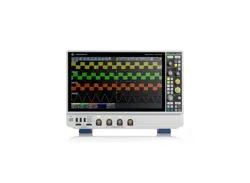Loading ...
Loading ...
Loading ...

Acquisition and waveform setup
R&S
®
MXO 5 Series
116User Manual 1802.3369.02 ─ 02
To set the offset automatically, use [Autoset]. The current value is shown in the signal
icon.
Use the offset to measure small AC voltages that are overlaid by higher DC voltages.
Unlike AC coupling, the DC part of the signal is not lost with offset setting.
If an active probe is connected, the offset limit is defined by the probe. Refer to the
documentation of the probe for allowed values.
If a Rohde & Schwarz differential probe is connected, set the common-mode offset to
compensate for a common DC voltage applied to both input sockets (referenced to the
ground socket). Thus, you can measure on differential signals with high common mode
levels. You can measure the common mode input voltage using the R&S ProbeMeter.
Remote command:
CHANnel<ch>:OFFSet on page 465
Position
Moves the selected signal up or down in the diagram. While the offset sets a voltage,
position is a graphical setting given in divisions. The visual effect is the same as for off-
set.
Remote command:
CHANnel<ch>:POSition on page 466
Coupling
Sets the filter for the input signal. The coupling determines what part of the signal is
used for waveform analysis and triggering.
The selected coupling is shown in the signal icon.
"DC"
Passes both DC and AC components of the signal.
"AC"
Connection through DC capacitor, removes DC and very low-fre-
quency components. AC coupling is useful if the DC component of a
signal is of no interest. The waveform is centered on zero volts.
If AC coupling is set, the attenuation of passive probes has no effect,
and voltage is applied to the instrument with factor 1:1. Observe the
voltage limits, otherwise you can damage the instrument.
Remote command:
CHANnel<ch>:COUPling on page 466
Termination
Selects the input impedance of the channel input according to the connected probe.
Connection with 50 Ω termination is used to connect, for example, active probes. Con-
nection with 1 MΩ termination is used to connect standard passive probes.
Remote command:
CHANnel<ch>:COUPling on page 466
Invert channel
Turns the inversion of the signal amplitude on or off. To invert means to reflect the volt-
age values of all signal components against the ground level.
Inversion is indicated in the signal icon by line above the channel name.
Vertical setup
Loading ...
Loading ...
Loading ...
